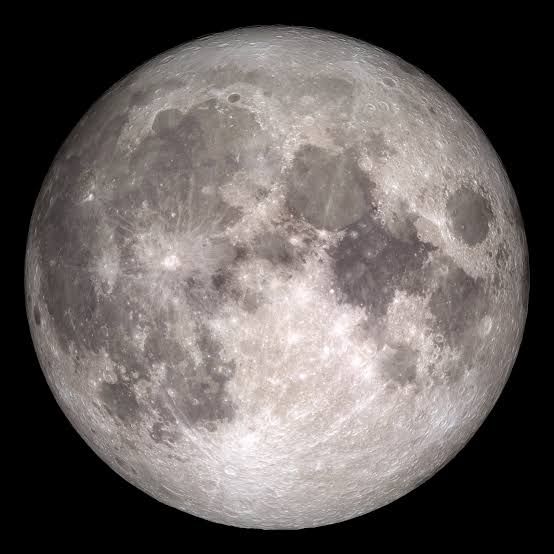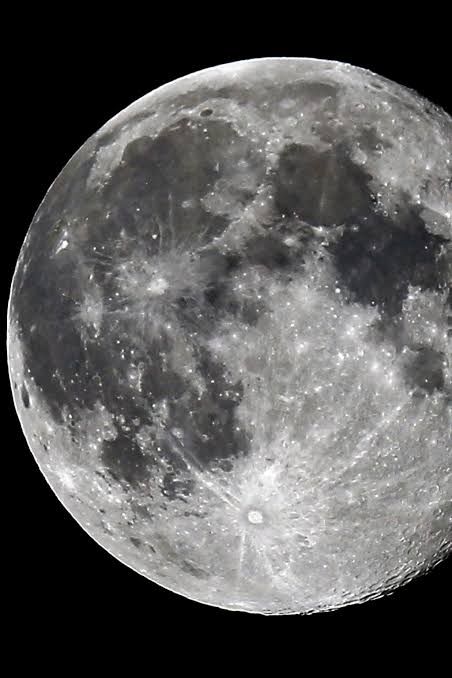
However, because it has a large angular diameter, the full moon is the brightest celestial object in the night sky.
...
Moon.
Designations
Apogee 405400 km (404000–406700 km)
Semi-major axis 384399 km (1.28 ls, 0.00257 AU)
Eccentricity 0.0549
Orbital period (sidereal) 27.321661 d (27 d 7 h 43 min 11.5 s)

The Moon is Earth's only natural satellite. At about one-quarter the diameter of Earth (comparable to the width of Australia),[16] it is the fifth largest satellite in the Solar System, the largest satellite in the Solar System relative to its major planet,[f] and larger than any known dwarf planet. The Moon is a planetary-mass object that formed a differentiated rocky body, making it a satellite planet under the geophysical definitions of the term.[17] It lacks any significant atmosphere, hydrosphere, or magnetic field. Its surface gravity is about one-sixth of Earth's (0.1654 g). Jupiter's moon Io is the only satellite in the Solar System known to have a higher surface gravity and density.

Designations
Designation
Earth I
Alternative names
LunaSelene (poetic)Cynthia (poetic)
Adjectives
LunarSelenian (poetic)Cynthian (poetic)Moonly (poetic)
Orbital characteristics
Epoch J2000
Perigee
362600 km
(356400–370400 km)
Apogee
405400 km
(404000–406700 km)
Semi-major axis
384399 km (1.28 ls, 0.00257 AU)[1]
Eccentricity
0.0549[1]
Orbital period (sidereal)
27.321661 d
(27 d 7 h 43 min 11.5 s[1])
Orbital period (synodic)
29.530589 d
(29 d 12 h 44 min 2.9 s)
Average orbital speed
1.022 km/s
Inclination
5.145° to the ecliptic[2][a]
Longitude of ascending node
Regressing by one revolution in 18.61 years
Argument of perigee
Progressing by one
revolution in 8.85 years
Satellite of
Earth[b][3]
Physical characteristics
Mean radius
1737.4 km
(0.2727 of Earth's)[1][4][5]
Equatorial radius
1738.1 km
(0.2725 of Earth's)[4]
Polar radius
1736.0 km
(0.2731 of Earth's)[4]
Flattening
0.0012[4]
Circumference
10921 km (equatorial)
Surface area
3.793×107 km2
(0.074 of Earth's)
Volume
2.1958×1010 km3
(0.02 of Earth's)[4]
Mass
7.342×1022 kg
(0.0123 of Earth's)[1][4][6]
Mean density
3.344 g/cm3[1][4]
0.606 × Earth
Surface gravity
1.622 m/s2 (0.1654 g; 5.318 ft/s2)[4]
Moment of inertia factor
0.3929±0.0009[7]
Escape velocity
2.38 km/s
(8600 km/h; 5300 mph)
Synodic rotation period
29.530589 d
(29 d 12 h 44 min 2.9 s; synodic; solar day) (spin-orbit locked)
Sidereal rotation period
27.321661 d (spin-orbit locked)
Equatorial rotation velocity
4.627 m/s
Axial tilt
1.5424° to ecliptic[8]
6.687° to orbit plane[2]
24° to Earth's equator [9]
North pole right ascension
17h 47m 26s
266.86°[10]
North pole declination
65.64°[10]
Albedo
0.136[11]
Surface temp. min mean max
Equator 100 K[12] 250 K 390 K[12]
85°N 150 K 230 K[13]
Surface absorbed dose rate
13.2 μGy/h[14]
Surface equivalent dose rate
57.0 μSv/h[14]
Apparent magnitude
−2.5 to −12.9[c]
−12.74 (mean full moon)[4]
Angular diameter
29.3 to 34.1 arcminutes[4][d]
Authors get paid when people like you upvote their post.
If you enjoyed what you read here, create your account today and start earning FREE BLURT!
If you enjoyed what you read here, create your account today and start earning FREE BLURT!
Sort Order: Trending
[-]
blurt.live · 3 years ago ·
